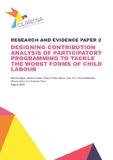| dc.contributor.author | Apgar, Marina | |
| dc.contributor.author | Snijder, Mieke | |
| dc.contributor.author | Prieto Martin, Pedro | |
| dc.contributor.author | Ton, Giel | |
| dc.contributor.author | Macleod, Shona | |
| dc.contributor.author | Kakri, Shanta | |
| dc.contributor.author | Paul, Sukanta | |
| dc.date.accessioned | 2022-08-18T11:05:51Z | |
| dc.date.available | 2022-08-18T11:05:51Z | |
| dc.date.issued | 2022-08-18 | |
| dc.identifier.citation | Apgar, M.; Snijder, M.; Prieto Martin, P.; Ton, G.; Macleod, S.; Kakri, S. and Paul, S. (2022) Designing Contribution Analysis of Participatory Programming to Tackle the Worst Forms of Child Labour, CLARISSA Research and Evidence Paper 2, Brighton: Institute of Development Studies, DOI: 10.19088/CLARISSA.2022.003 | en |
| dc.identifier.uri | https://opendocs.ids.ac.uk/opendocs/handle/20.500.12413/17603 | |
| dc.description.abstract | This Research and Evidence Paper presents the theory-based and participatory evaluation design of the Child Labour: Action-Research- Innovation in South and South-Eastern Asia (CLARISSA) programme. The evaluation is embedded in emergent Participatory Action Research with children and other stakeholders to address the drivers of the worst forms of child labour (WFCL). The report describes the use of contribution analysis as an overarching approach, with its emphasis on crafting, nesting and iteratively reflecting on causal theories of change. It illustrates how hierarchically-nested impact pathways lead to specific evaluation questions and mixing different evaluation methods in response to these questions, critical assumptions, and agreement on causal mechanisms to be examined in depth. It also illustrates how realist evaluation can be combined with contribution analysis to deeply investigate specific causal links in the theory of change. It reflects on learning from the use of causal hotspots as a vehicle for mixing methods. It offers considerations on how to navigate relationships and operational trade-offs in making methodological choices to build robust and credible evidence on how, for whom, and under what conditions participatory programming can work to address complex problems such as child labour. | en |
| dc.language.iso | en | en |
| dc.publisher | Institute of Development Studies | en |
| dc.relation.ispartofseries | CLARISSA Research and Evidence Paper;2 | |
| dc.rights.uri | http://creativecommons.org/licenses/by/4.0/ | en |
| dc.title | Designing Contribution Analysis of Participatory Programming to Tackle the Worst Forms of Child Labour | en |
| dc.type | Series paper (non-IDS) | en |
| dc.rights.holder | © Institute of Development Studies 2022 | en |
| dc.identifier.doi | 10.19088/CLARISSA.2022.003 | |
| rioxxterms.funder | Department for International Development, UK Government | en |
| rioxxterms.identifier.project | CLARISSA | en |
| rioxxterms.version | VoR | en |
| rioxxterms.versionofrecord | 10.19088/CLARISSA.2022.003 | en |
| rioxxterms.funder.project | 72238f40-e8c4-4e20-a724-1ad49f5d3f6c | en |


